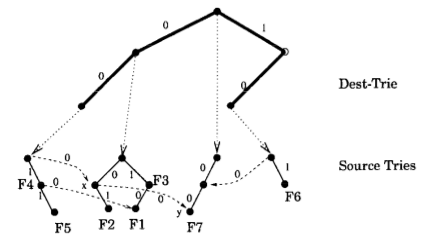Links
Abstract
In Layer Four switching, the route and resources allocated to a packet are determined by the destination address as well as other header fields of the packet such as source address, TCP and UDP port numbers. Layer Four switching unifies firewall processing, RSVP style resource reservation filters, QoS Routing, and normal unicast and multicast forwarding into a single framework. In this framework, the forwarding database of a router consists of a potentially large number of filters on key header fields. A given packet header can match multiple filters, so each filter is given a cost, and the packet is forwarded using the least cost matching filter. In this paper, we describe two new algorithms for solving the least cost matching filter problem at high speeds. Our first algorithm is based on a grid-of-tries construction and works optimally for processing filters consisting of two prefix fields (such as destination-source filters) using linear space. Our second algorithm, cross-producting, provides fast lookup times for arbitrary filters but potentially requires large storage. We describe a combination scheme that combines the advantages of both schemes. The combination scheme can be optimized to handle pure destination prefix filters in 4 memory accesses, destination-source filters in 8 memory accesses worst case, and all other filters in 11 memory accesses in the typical case.
BibTeX (Download)
@inproceedings{Srinivasan1998Fast,
title = {Fast and Scalable Layer Four Switching},
author = {V. Srinivasan and George Varghese and Subhash Suri and Marcel Waldvogel},
url = {https://netfuture.ch/wp-content/uploads/1998/srinivasan98fast.pdf},
year = {1998},
date = {1998-09-01},
urldate = {1000-01-01},
booktitle = {Proceedings of ACM SIGCOMM},
pages = {191-202},
abstract = { In Layer Four switching, the route and resources allocated to a packet are determined by the destination address as well as other header fields of the packet such as source address, TCP and UDP port numbers. Layer Four switching unifies firewall processing, RSVP style resource reservation filters, QoS Routing, and normal unicast and multicast forwarding into a single framework. In this framework, the forwarding database of a router consists of a potentially large number of filters on key header fields. A given packet header can match multiple filters, so each filter is given a cost, and the packet is forwarded using the least cost matching filter. In this paper, we describe two new algorithms for solving the least cost matching filter problem at high speeds. Our first algorithm is based on a grid-of-tries construction and works optimally for processing filters consisting of two prefix fields (such as destination-source filters) using linear space. Our second algorithm, cross-producting, provides fast lookup times for arbitrary filters but potentially requires large storage. We describe a combination scheme that combines the advantages of both schemes. The combination scheme can be optimized to handle pure destination prefix filters in 4 memory accesses, destination-source filters in 8 memory accesses worst case, and all other filters in 11 memory accesses in the typical case.},
keywords = {Fast Routers, Hash Tables, Quality of Service},
pubstate = {published},
tppubtype = {inproceedings}
}




